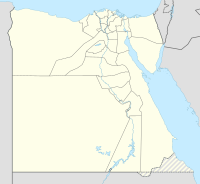Gebel Kamil
Coordinates: 22 ° 1 ′ 6 " N , 26 ° 5 ′ 15.7" E
Gebel Kamil ( Arabic جبل كامل, DMG Ǧabal Kāmil - Italian spelling for “Djebel Kamil”, pronounced “dschebel kamil”) is a meteorite whose crater ( Kamil crater ) was found in the vicinity of the mountain Djebel Kamil in Egypt .
In 2009 Vincento De Michele discovered a strange rock formation with Google Earth in the East Uweinat Desert in southwest Egypt near the border with Sudan , which turned out to be an impact crater with a diameter of 45 meters. The difference in height from the crater rim to the center of the crater is about 8 meters, where about 2 meters of aeolian sediments have already been deposited. Satellite images show that geologically, this crater must still be very young, as the ejecta cover is easy to see. So far, the researchers assume that the impact is less than 5000 years old, as human traces are covered by ejecta. Impact glass was identified in the vicinity of the crater . During two Italian-Egyptian expeditions to this crater in February 2009 and February 2010, over 1.6 tons of meteoritic material were collected, with even more material being found and mapped. The meteorite is classified as an ungrouped iron meteorite . It has an ataxite structure with embedded writersite , troilite and daubréelite crystals.
The fact that not only the usual soil material but also thousands of fragments of the meteorite itself were found in the immediate vicinity of the impact point is considered an unusual fact. Scientists conclude from this that Gebel Kamil was able to cross the earth's atmosphere largely undestroyed despite its low mass of (estimated) only 5 to 10 tons and only broke when it hit the ground. Until now, it was assumed that meteorites with a mass of less than 3000 tons could not withstand the thermal and mechanical loads when crossing the atmosphere and would break long before they reached the ground.
Individual evidence
- ↑ Meteoritical Bulletin No. 98, MAPS 45.
- ↑ Even small meteorites pierce the atmosphere , accessed on July 23, 2010
swell
- Luigi Folco, et al. : The Kamil Crater in Egypt . In: Science . tape 329 , no. 5993 , 2010, pp. 804 , doi : 10.1126 / science.1190990 .
- National Geographic "Daily News" "Fresh" Crater Found in Egypt; Changes Impact Risk? Retrieved July 23, 2010
- Science.orf.at A crater called Kamil. Retrieved July 24, 2010
Web links
- The Kamil crater in Egypt
- Kamil - a young impact crater in Egypt
- Video KAMIL UN CRATERE LUNARE SULA TERRA ( MOV ; 9.4 MB) Retrieved November 9, 2010
- The Kamil Crater in the Earth Impact Database


